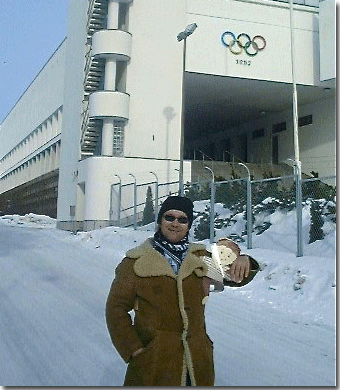“Why don’t you put on your coach’s coat?”
– Son, on our way to his bandy practice.
It’s cold out there. It’s cold standing by the side of a huge bandy arena, with the winds blowing the full length of the ice, when the temperature is already in the double digits below zero. My new winter coat is a precious memento from the Vancouver Olympics that I covered for the IIHF, but that’s not the coach’s jacket that Son meant. That’s the 21st century version, but Son was talking about my other winter coat.

It’s waist length, light brown, with formerly white fur linings, a leather coat from the 1970s that evokes images of the true coaches of the era: Anatoly Tarasov, the big man behind Soviet hockey programs and his daughter Tatiana Tarasova, whose students have won over 40 World and European Championship gold medals and seven Olympic gold medals.
It’s also my Dad’s old coat.
Dad wasn’t my first coach, and he wasn’t my last coach, but he pretty much coached me all those years in-between. Being the coach’s son isn’t always easy, because contrary to what you may believe, dad-coaches ride their sons pretty hard, to make sure they can’t be accused of favoritism.
But he was a great coach, and sometimes I’ve wondered if he wasn’t the true talent of us. Maybe, instead of him trying to help me become a great hockey player, he should have made an attempt to make hockey a real career for himself.
However, I was a pretty good prospect at one time, so we traveled through minor hockey together. Dad took me to open skates at a local rink so I could practice stopping with one skate, we’d skate against the stream of people to learn how to make dekes. The other people didn’t always appreciate it, and one time, a buddy of mine ran into a bigger fellow and broke his nose. His own.
It’s safe to say that Tarasov was Dad’s idol. One late summer, the man who didn’t go to school too much spent hours and hours putting together a booklet that included one part Finnish hockey federation’s coach instruction material, and nine parts Tarasov’s notes, thoughts, and comments on hockey.
When Dad read in a book that Tarasov had said that real players carry their own bags, that became the rule for the team and around the house, a one that he still likes to repeat. When he read in Kharlamov’s book that Tarasov had once made his team jump on one leg for an entire period, to make the game a harder challenge, a certain Helsinki junior team did the same. Not that we were as dominant as the Red Army team, but surely there was a lesson to be learned for Finnish 12-year-olds, too.
Dad got to meet Tarasov, and our team got to taste some of that tough Soviet love, in 1984. It was summer, so Tarasov wasn’t wearing a fur coat.
He was standing in the middle of a concrete tennis court, and we were asked to gather around him. A few of the guys came running through a hole in the fence. Tarasov wouldn’t take it, so he made the guys go back through the hole, run around through the real opening – and then do three forward rolls on the concrete right there. That got our attention.
Next, we walked to a tiny grass knoll around the corner, and started our Soviet workout: run up birch tree trunks, and make full somersaults on grass. Trial, error, and pain.
I guess you know what we did the rest of the summer. I haven’t tried it for years, but if I did, I would definitely want to get three steps up the tree, because that was the limit Big Anatoly – and Dad – set for us.
I played and Dad coached. For about ten years, we lived hockey together. Then I graduated from high school.
That summer, Dad and I were shooting hoops at the local school’s yard, just a few hundred meters from the house. We played a few games of H-O-R-S-E and chatted and hung out. Feeling all sentimental, on the verge of true adulthood, just a couple of weeks before I went to college, I remember thinking what a cool man he was, and that I wished that when I’d be his age, I, too, would still want to, and be able to, hang out like that.
But Dad wasn’t an old man, by any means.
He couldn’t have been because today, as I put on my coach’s coat, I am older than he was back then.

I really enjoyed this story. My dad was my basketball coach growing up, so I related to it as well. I want that coat…looks so warm.